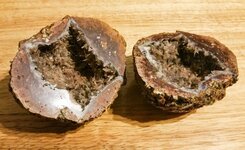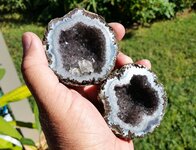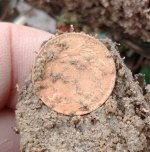SkySgt
Jr. Member
- Jan 19, 2014
- 73
- 37
- Detector(s) used
- Garrett ATX (PI) and Garrett Ace 350 (VLF) detectors.
- Primary Interest:
- All Treasure Hunting
Can anyone identify each of these geode types by common name, if they have one (i.e., Keokuk geode)? Since I bought them, uncut, from a guy who bought them at an estate sale, I have no way of determining where they originated. A gentleman at our local geological society believes the brown geode likely originated in Mexico.
The brown geode has many "needles" growing inward from the inside walls. These crystals are generally clear to brown in color. The cross-section of the geode wall shows at least three different colors/materials. The innermost wall material is a milky white to grayish color agate that polishes very well. The next material outward is dark brown and only polishes to a semi-gloss. The outermost material is light brown in color and will not polish at all. The outer material of the geode wall is greenish in color and looks as if it were rolled in thousands of light brown mini-pebbles. These pebbles will come off if you were to rub your hand over the geode's surface.
The second geode has a dark gray to dark chocolate exterior color, and is splotched with areas of what looks like a whitish mildew. The texture is very pitted and has many sizeable vugs. The inner cavity is covered with beautiful smokey quartz crystals. One half of the geode has what looks to be three large clear calcite crystals, with a light brown inclusion in two of them.
Any help in obtaining identification of each of these geodes will be greatly appreciated.


UPDATE - The "brown thunderegg" is actually called a Reverse Scepter Quartz Needle Geode. They're from Mexico. Another example can be seen here:
http://www.spiritrockshop.com/Geode_Reverse_Sceptor.html
The other geode pair is an Amethyst Quartz Geode. Hints of purple can be seen in the image, in sunlight. Indoor lighting makes it look like Smoky Quartz.
The brown geode has many "needles" growing inward from the inside walls. These crystals are generally clear to brown in color. The cross-section of the geode wall shows at least three different colors/materials. The innermost wall material is a milky white to grayish color agate that polishes very well. The next material outward is dark brown and only polishes to a semi-gloss. The outermost material is light brown in color and will not polish at all. The outer material of the geode wall is greenish in color and looks as if it were rolled in thousands of light brown mini-pebbles. These pebbles will come off if you were to rub your hand over the geode's surface.
The second geode has a dark gray to dark chocolate exterior color, and is splotched with areas of what looks like a whitish mildew. The texture is very pitted and has many sizeable vugs. The inner cavity is covered with beautiful smokey quartz crystals. One half of the geode has what looks to be three large clear calcite crystals, with a light brown inclusion in two of them.
Any help in obtaining identification of each of these geodes will be greatly appreciated.


UPDATE - The "brown thunderegg" is actually called a Reverse Scepter Quartz Needle Geode. They're from Mexico. Another example can be seen here:
http://www.spiritrockshop.com/Geode_Reverse_Sceptor.html
The other geode pair is an Amethyst Quartz Geode. Hints of purple can be seen in the image, in sunlight. Indoor lighting makes it look like Smoky Quartz.
Last edited:





